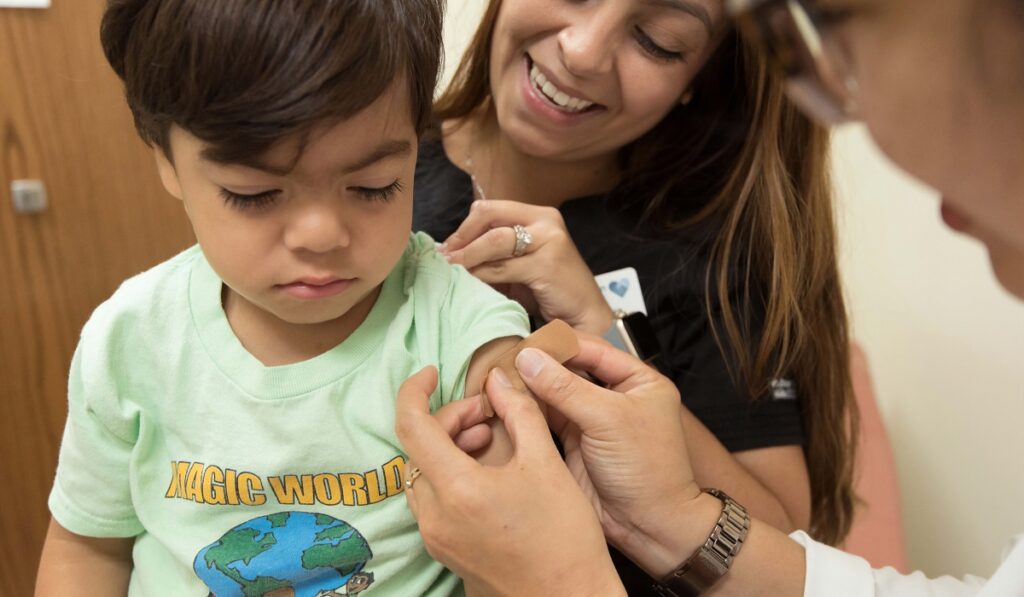The global rate of childhood vaccination “stalled in 2023,” the World Health Organization (WHO) says. Figures released July 15 show 2.7 million more children were unvaccinated or under-vaccinated in 2023 than in 2019.
The inability to achieve pre-pandemic levels of childhood immunization needlessly puts young lives at risk. “Immunization is one of the most cost-effective public health interventions, averting an estimated 4.4 million deaths yearly,” according to UNICEF.
The new findings, based on data from WHO and UNICEF, show disturbing trends:
- Globally in 2023, there were 14.5 million “zero-dose children,” who had not received any vaccination.
- Only 84% of eligible children had received their third dose of one of the most standard vaccines, DTP3, protecting against diphtheria, tetanus, and pertussis, in 2023.
- Only 83% of eligible children received their first dose of measles vaccine in 2023, well below the 2019 level of 86%.
- Coverage of yellow fever vaccine in the countries at risk of it is 50%, well below the recommended 80%.
- Human papillomavirus (HPV) vaccination rates actually improved. Global coverage for the first dose in girls increased from 20% in 2022 to 27% in 2023.
Although WHO says “more than half of unvaccinated children live in the 31 countries with fragile, conflict-affected and vulnerable settings,” there are several types of vaccines in which wealthy, stable countries fall short.
Measles remains a challenge
Measles vaccination is lagging in the U.S. and Europe, driving surprising outbreaks of this disease in places where it was nearly eradicated.
Herd immunity requires 95% vaccination. However, measles vaccination rates below 90% were recorded in 12 U.S. states for the 2022-23 school year, NBC reports. Although measles was declared eliminated in the U.S. in 2000, vaccination rates have lagged since the pandemic, threatening the nation’s elimination status.
Measles is the “canary in the coal mine” when it comes to predicting the emergence of other preventable diseases, explained Patricia (Patsy) A. Stinchfield, RN, MS, CPNP, President of the National Foundation for Infectious Diseases (NFID), in an interview with Bio.News. Measles is the most contagious human virus and, therefore, usually the first out of the gate. According to NFID, measles is so contagious that if one person has it, up to 90% of the people close to that person who are not immune will also become infected.
“The rise of measles is of great concern—a very safe and effective vaccine is available to prevent the disease and greatly decrease the burden on children, parents, schools, and the entire healthcare ecosystem,” Phyllis Arthur, EVP and Head of Healthcare Policy and Programs at the Biotechnology Innovation Organization (BIO), has said.
Good news on HPV vaccination
The data was not all gloomy.
“The steady introduction of new and under-utilized vaccines, including for human papillomavirus (HPV), meningitis, pneumococcal, polio and rotavirus disease, continue to expand the breadth of protection, particularly in the 57 countries supported by Gavi, the Vaccine Alliance,” the WHO says.
Gavi is a network bringing together, governments, vaccine manufacturers, international organizations like WHO, and others, to improve public health by promoting global immunization.
The HPV vaccine has been shown to completely prevent cervical cancer among vaccinated young women in a study in Scotland. Cervical cancer is the “second most common cancer and the leading cause of cancer death in women in sub-Saharan Africa,” Bio.News reports.
Thanks to campaigns in Gavi-supported countries like Bangladesh, Indonesia, and Nigeria, HPV vaccination has increased. It also helps that the WHO declared in 2022 that a single HPV vaccine was effective, and the previously recommended course of two doses was not necessary—a decision that effectively doubled the number of doses available.




